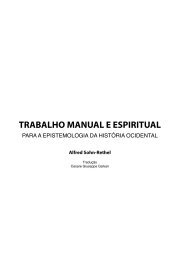Perversion the Social Relation
Perversion the Social Relation
Perversion the Social Relation
- No tags were found...
You also want an ePaper? Increase the reach of your titles
YUMPU automatically turns print PDFs into web optimized ePapers that Google loves.
74 Octave Mannoniwithin two days, I found my mo<strong>the</strong>r in a nearby house, baking piki. Ihad entered unexpectedly and discovered that she was making red piki.When I saw that it was red piki... I was upset. . . . That evening atsupper ... I ate almost nothing. . . . The next day when <strong>the</strong> Katcinaswere distributing <strong>the</strong>ir gifts to us I did not want any of <strong>the</strong>ir . . . piki.But to my surprise <strong>the</strong>y gave me not red but yellow piki Then I washappy" (75-6)7This time, <strong>the</strong>n, Talayesva has managed to avoid giving up his belief,thanks to his clever mo<strong>the</strong>r's ploy. As to <strong>the</strong> o<strong>the</strong>r judgment, "Mamais fooling me," it is hard to say what becomes of it. It must be presentsomewhere. It can be seen that what we might call a first test of disavowalcauses anxiety, and is not far from being a traumatic ordeal; ouryoung Hopi is relieved to escape it. This crisis is akin to <strong>the</strong> one thatFreud assumes <strong>the</strong> future fetishist undergoes, and, as it is not directlyaccessible, proceeds to reconstruct: it is an unheimliche, traumatic moment,that of <strong>the</strong> discovery of reality. Beyond <strong>the</strong> shadow of a doubt,<strong>the</strong> crisis of belief in <strong>the</strong> Katcinas reproduces, as its model, <strong>the</strong> structureof <strong>the</strong> crisis of belief in <strong>the</strong> phallus. Similarly, Freud saw in <strong>the</strong> crisislinked to castration <strong>the</strong> model for <strong>the</strong> kinds of panic that erupt later inlife, when people are suddenly overwhelmed by <strong>the</strong> feeling that "Throneand Altar are in danger." We will already have recognized castration in<strong>the</strong> emotion that overcomes <strong>the</strong> young Hopi when he is confronted with<strong>the</strong> red piki. The alarm soon passes; it is a mere foretaste of what willoccur when <strong>the</strong> boy reaches <strong>the</strong> age of ten or so, <strong>the</strong> age of initiation.Yet it is not a matter of indifference, in my view, that things should thustranspire in two distinct periods. This makes an "it was true after all"possible, and this repetition certainly plays an important role.When <strong>the</strong> children are initiated—in <strong>the</strong> course of ceremonies that areintended to be as impressive as possible, and that directly evoke castration—<strong>the</strong>adults who are known as fa<strong>the</strong>rs and uncles in <strong>the</strong> Hopi kinshipsystem reveal, by removing <strong>the</strong>ir masks, that <strong>the</strong>y were <strong>the</strong> oneswho played <strong>the</strong> Katcinas. How do <strong>the</strong> initiated react when <strong>the</strong>y learn<strong>the</strong> truth?"When <strong>the</strong> Katcinas entered <strong>the</strong> kiva without masks," Talayesvawrites, "I had a great surprise. They were not spirits. ... I recognizedall of <strong>the</strong>m, and I felt very unhappy, because I had been told all my lifethat Katcinas were gods. I was especially shocked and angry when I saw








